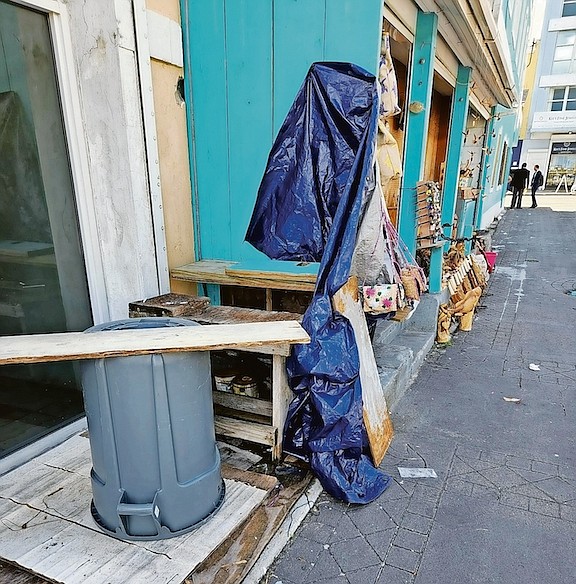IT’S amazing what trying to look at something through someone else’s eyes can reveal.
Say that someone else is a visitor who is accustomed to landlocked hills and valleys and the emotion they must feel when they first set sight on the stunning turquoise waters of The Bahamas -- eyes wide open, staring in wonder at the jaw-dropping beauty unfolding before them. A vision that matched or exceeded the glory of The Bahamas promised in all the tourist books and ads.
Or when that same visitor who is accustomed to a clean town with attractive plantings and wide sidewalks steps onto a side street off Bay Street and is hit smack in the eyeballs by what looks like a poor Middle East market with clothes, totes and bags hanging outside a dusty window though you can hardly see the dust for the hand-written signs taped all over the window.
The two faces of The Bahamas – those breathtaking waters wrapped in the outstretched arms of a half-moon beach with water so clear you can read heads and tails on a coin below, in contrast to the tackiness of a city in desperate need of management and tender, loving care, a city that should be the heartbeat of a nation, and was once the pride of the country? How do you reconcile the differences between those two faces to find a solution that every face we show is one that not just brings a smile to the visitor but a sense of pride to us as Bahamians as we start our journey to 50 years of independence?
We show the best and the worst to our visitors that we spend a fortune every year to lure here, though the cruise industry does the heavy lifting on its business, delivering millions of people it’s up to us to impress enough to attract them back as stayover visitors or to return on another cruise.
The treasures we show them – our waters, our palms and mangroves, our endless horizon of clear blue sky, our sunsets and sunrises that take your breath away – are the elements we inherited.
The disgraces we show them are the mess we have made of what we were given.
We can spend any amount of money celebrating our 50th but if we do not face the reality that an historic city that is not aging gracefully needs a mayor or manager, along with the right to govern its destiny, we are, pardon my frankness, spitting into the wind.
No mom or pop shop over the hill opens without a manager in place and yet we open the capital of our country, the first place and last space millions of visitors see every year, without any management whatsoever. This is not to downplay the attempts by the Downtown Nassau Partnership to do what it can, nor to ignore the fact that there is a new tourism police station or an increase in police presence, but look at the economic, social and cultural reality.
We are not alone in this. Look at New York, Baltimore, Boston, Philadelphia, even Atlanta and Savannah, all cities that fared worse for neglect but were brought back to life. Look at a community like Greenwich Village or Chelsea in New York, the latter once a meat-packing district that no one ever dreamed would be the sought-after address for arts, photography, ad production, videography, expensive lofts and tony delis. Look at Vienna in Austria or Venice in Italy.
Is it a news flash to remind ourselves that it is not the state that saves economies, but the city that is the main player in macro-economics?
The living city is part of our connectedness, our oneness, our sense of community.
I am no urban planner, no architect, draftsman or designer. I am just someone who loves historic Nassau and gave years of my life trying to protect and preserve what I believe is one of the most precious architectural treasures in the region.
Our trees, our harbour, our views, our walkways are all important elements, but it is the bones of our buildings, few more than two stories high, that together make a quilt of the finest structural components. In 2006, we unveiled the Master Plan for Historic Nassau. Watching it brought tears to the then Prime Minister Perry Christie’s eyes. I shall never forget that event nor the promises that were made to save the historic City of Nassau before it was too late.
It is still not too late. But the clock is ticking with every hand-hewn piece of woodwork replaced by something manufactured in bulk, every arched entry replaced by a straight line, every courtyard alive with greenery looked at for how it can become a roofed-in revenue generator.
May the road to 50 be more than a pat on the back for some and a party for all.
May it be the moment we take a deep breath and resolve to save the historic city that is the capital and the most famous landmark in of the nation whose independence we celebrate.
A short note about climate change
TROPICAL storm Nicole that hurled through Abaco and Grand Bahama as it worked its way into hurricane status was the latest in a series of potentially catastrophic events that made everyone pay attention to weather, even those who continue to deny the reality of climate change. Part of the problem with telling the story of climate change is that we tend to focus on major events like a Nicole, an Ian, the hurricane that devastated so much of southwest Florida weeks earlier, or Dorian two years before.
By thinking in terms of the dramatic events, we leave ourselves open to those who say typhoons, hurricanes, earthquakes have happened as long as there has been life on earth. Cities vanish underwater, islands rise and disappear, weather has created deserts and plains. It’s all cyclical, the climate change deniers say.
And, in a way, they are right, there have been cyclical catastrophic events throughout history, though they come at us faster and with greater intensity and strength now than they did before.
But the reality we should focus on that leaves no doubt about climate change is the less dramatic events, the slowly rising temperatures that will impact agriculture, heat waves, drought, less rainfall, all of which will cause a decline in food security, eventual increase in illness, malnutrition, starvation and even death in the poorest of countries affected by the changes. Bangladesh, Haiti, the Philippines, Honduras, Nicaragua and least able to pay the price will do just that.
To save nature is to save humanity. That is the discussion we need to have around climate change.






Comments
BONEFISH 1 year, 5 months ago
When I walk down town Nassau, I experience three different set of feelings. Depression,sadness and anger. Why are things like this down town for years.
The local government officials in the american city where my sister lives, do things routinely which the government officials here have never mastered Some of them are:
There are many other things they do. I would not mention. The city has a city manager also.
The reason you won't see a real local government system in this country is because of the vested interests. Too many persons benefit from the current status quo.
Sign in to comment
Or login with:
OpenID